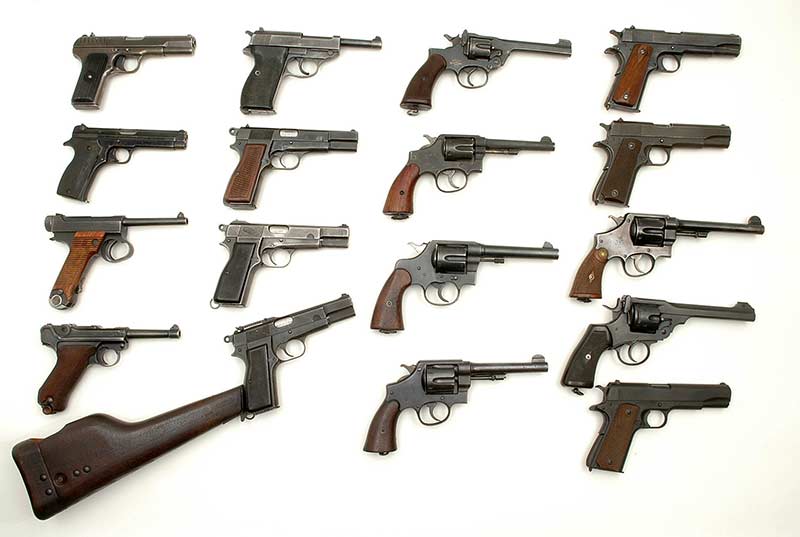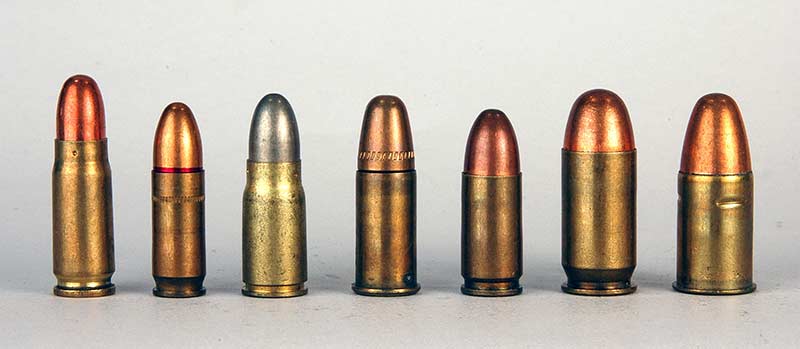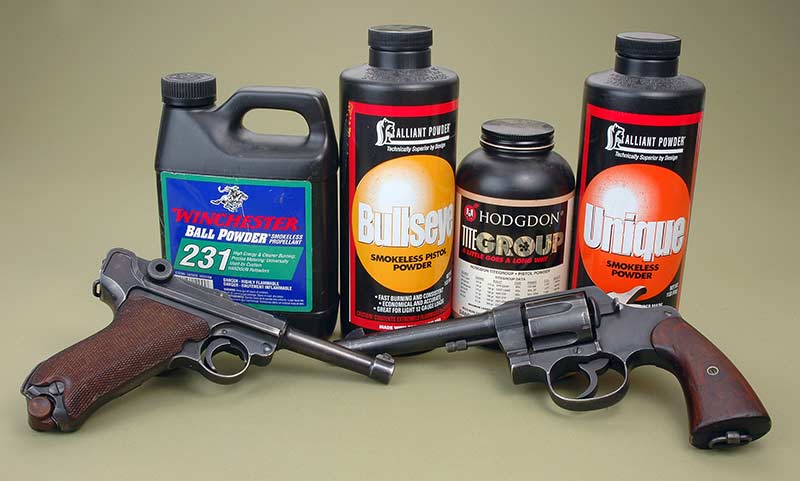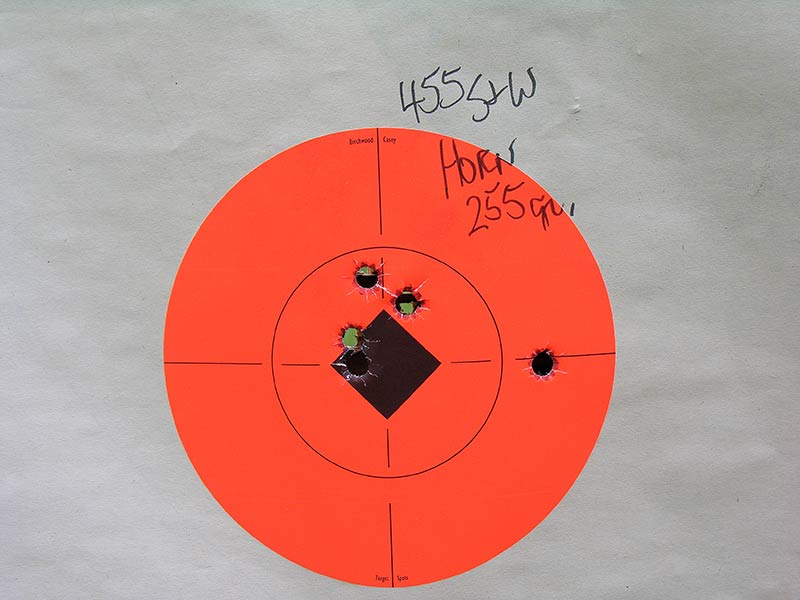Handguns Of WWII Part 13
Powders For Reloading World War II Handguns

All of these handguns save one make up Duke’s World War II handgun collection. The one not belonging to him is the
Soviet TT33 7.62x25mm. First row from top: Soviet TT33, French Model 1935A, Japanese Type 14, German P08 (Luger).
Second row from top: German P38, German P35 (actually made by FN in Belgium), Canadian Inglis P35, Canadian Inglis P35
(with shoulder stock) Third row from top: British Enfield No. 2, S&W S&W Military & Police (made for British),
U.S. Model 1917 (Colt), U.S. Model 1917 (S&W), Fourth row from top: U.S. Model 1911 (Colt), U.S. Model 1911A1 (Colt),
S&W HE #2 (made for Canada), British Webley Mk VI and at bottom is a modern U.S. Model 1911A1 by Colt.
Part 13 Of A 13-Part Series
My attitude is the major handgun cartridges which saw significant combat in World War II in the hands of infantrymen number seven. They are Soviet/7.62x25mm Tokarov, French 7.65mm Long, Japanese 8mm Nambu, Germany and others 9mm Parabellum, British .380 Revolver, United States .45 ACP and British .455 Webley.
Case shapes of these seven range from straight to bottleneck with rimless and rimmed case heads. As to bullet diameter, on the small size was the Soviet 7.62x25mm Tokarov. At the big end is the British .455 Webley. Those two used .308″, 86 gr. and .45″, 265 gr.bullets respectively, with the lighter one speeding at 1,500 fps and the heavier one lumbering along at about 600 fps.
One factor shared by all standard issue World War II handgun cartridges is their cartridge cases were small. The .455 Webley case length is only .75″ and the 7.65x25mm Tokarov is .9″. All the others fit inside those parameters. Short case lengths translate into small case capacity, which in turn means to modern handloaders that fast burning pistol powders must be used when reloading all these calibers.
Those of proper burning rate range from Bullseye to Unique. Still according to Lyman’s “RELOADING HANDBOOK #49” that includes at least 22 different propellants. Personally speaking, and based on firing thousands of rounds through dozens of World War II issue handguns these past few years, I can further trim them down to four. Those are Bullseye, Winchester 231(aka HP38), Titegroup and Unique. If I could only have two of those four they would be Bullseye and Titegroup.
If only one was possible it would be Bullseye; not because it gives superior accuracy in all rounds but because it comes closer to duplicating original military ballistics across the board. See the accompanying photos of groups fired to see how both Titegroup and Bullseye scored in regards to putting one bullet after another in close proximity. But, I’m not limited to one or two powders so I’ll give some details of what I have discovered to be optimum choices in these seven military calibers.
SOVIET 7.62x25mm TOKAROV
This cartridge has the smallest bullet but fires it at the highest velocity of all the World War II rounds. According to several sources that is 1,500 fps with 86 gr. bullets. I couldn’t make that happen in the real world of safe handloading using 86 gr. Hornady jacketed soft point bullets. From a vintage Soviet TT33 6.0 grs. of Unique gave just over 1,200 fps. My PPsh41 submachine gun actually did break 1,500 fps with that load. With 85 gr. cast bullets 6.0 grs. of Unique hit 1,450 fps.
7.65mm FRENCH LONG
By no means can this round be considered one of the most significant World War II handgun cartridges, but I’ve included it because one of the handsome Model 1935A French pistols was the very first handgun that fell into my hands in my youth. The pistol is nice but the cartridge is woefully underpowered for a military one. It is rated at 1,100 fps with an 85 gr. bullet. Using the same 85 gr. cast bullet as used in the above Soviet cartridge — only sized .312″ instead of .310″ — the velocity clocked was 1,095 fps. Powder charge was 3.0 grs. of Titegroup. Also, as the photo shows, that load printed exactly to the sights at 25 yards.
JAPANESE 8MM NAMBU
Again we have an underpowered cartridge coupled with a nicely made handgun, although it should be said Nambu Type 14 pistols are not as pleasing to the American eye as are the French Model 1935As. Because a very generous World War II USMC veteran gave me some original 8mm Nambu ammunition he took from the body of a Japanese officer he killed on Iwo Jima, I was able to determine exactly what bullet weight they carried. It weighed 102 grains. Various sources say it was propelled at speeds of from 1,000 to 1,100 fps. With 106 gr. cast bullets a charge of 3.5 grs. of Titegroup gave 999 fps from my Type 14. That’s close enough to suit me.
9mm PARABELLUM
Since the 9mm was used by several nations, from Germany to Canada, pinning down exact ballistics is a trial. However, at a gun show in Montana I bought a box of 9mm Parabellum labeled “NATO” so I have used that as a standard. Bullet weight for that load is 115 grs. and it chronographed from the 4″ barrel of my Luger P08 at 1,125 fps. That is essentially duplicated by 115 gr. FMJ bullets over 4.4 grs. of Winchester 231 (aka HP38). Velocity for that load was 1,118 fps from the 4 5/8″ barrel of my Inglis P35 Hi Power and 1,116 fps from the P08 Luger.
BRITISH .380 REVOLVER
Here we have a bit of a conundrum. The Brits developed this round with a 200 gr. lead bullet at about 600 fps from their little Enfield No. 2 revolvers. However because of civilized rules of warfare pacts that most European nations signed, they were fussed at because of the lead alloy bullet. It needed to be full-metal-jacketed. That reduced bullet weight to 178 grains. Try finding a bullet in that weight range. So, I’ve just made myself happy by using 200 gr. lead bullets. Loaded over 1.7 grs. of Titegroup they give 610 fps from my Enfield No. 2 and shoot quite accurately.
UNITED STATES .45 ACP
It has been long accepted the standard .45 ACP military load is a 230 gr. FMJ bullet at about 830 fps from the 5″ barrels of U.S. Model 1911A1 pistols. At the same gun show in Montana at which I found the NATO-labeled 9mm rounds, I also found a box of military .45 ACP ammo headstamped WCC66. These chronographed 843 fps from my Colt U.S. Model 1911A1 and also the same from a Colt Model 1917 .45 ACP revolver. With 230 gr. FMJ bullets over 4.8 grains of Titegroup, velocity was 800 fps from the U.S. Model 1911 and 812 fps from the Colt 1917 revolver. However substituting a 227 gr. cast bullet for the jacketed ones raised speeds to 852 fps and 858 fps from the same handguns respectively.
BRITISH .455 WEBLEY
Military ballistics for the big .455 revolvers are rated at 600 fps with a 265 gr. FMJ bullet. Having no original military loads to shoot I leaned on Hornady’s new factory load to set my standard. It gave 597 fps from the 6″ barrel of a Webley Mk VI. A 264 gr. lead alloy bullet over 3.0 grains Bullseye (I’ve tried several different bullets) gave 611 fps. There is one change I do make occasionally. That is using Hornady’s 255 gr. swaged lead bullet. Loaded over 4.0 grs. of Bullseye, it hits exactly to point of aim with my S&W Hand Ejector, 2nd Model .455. Its velocity is 714 fps.
With fast burning, easily ignited powders, only standard strength pistol primers are necessary for all these World War II cartridges. From good guns, they all deliver accuracy levels of the sort for which they were designed.
Click here to links to all the 13-part on-line series of Handguns Of World War 2 articles.










